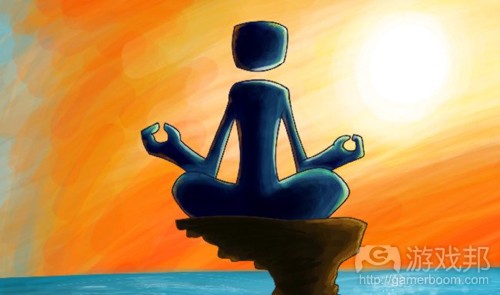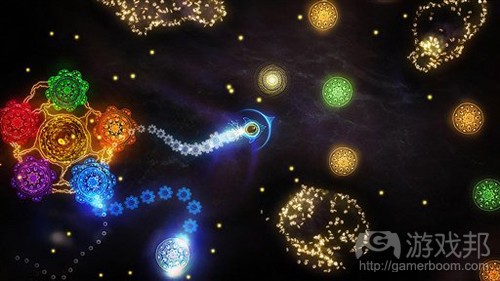列举3种带有冥想功能的游戏类型
作者:Ben Serviss
游戏乐趣正遭到破坏。可能不大严重,但明显遭到排挤。David Cage希望游戏行业利用成熟主题制作出基于目标的游戏;Jane McGonigal希望通过游戏延长用户10年寿命;Frank Lantz在纽约大学Global Game Jam网站的简介中,鼓励开发者注重创造欢乐,而非“高估趣味的重要性”。
然而,有些游戏多年来一直致力于另一个目的:冥想。
冥想的核心是静止运动,放松大脑,而后深刻思考人生以及自己在世界上的地位。希望通过这种反复集中心思内省,排除生活中的无数干扰与意外。可惜,绝大多数人都认为冥想是种枯燥活动。
(THQ与Deepak Chopra的《Leela》试图完全基于冥想,创建出带有不同结果的体验。)
幸好,我们还可通过其它渠道冥想,虽然效果不大理想,但总好过不进行任何反思。比如,参与快速重复的体育活动(游戏邦注:包括跑步、骑车、滑冰、滑雪),通过身体与心理过程的分离,同样可以触发沉思感。而且,这种重复性支持身体继续自动运转,同时大脑能够有意识(或无意识)地自由思考。借此释放精神,超然脱俗,但有点恐怖。
使用这种冥想并不是难题。因此为何不制作引起这类反应的游戏呢?虽然有些作品仍在尝试中,其它游戏则在无意间实现这种理念,但开发者似乎会采取以下三种方法,且对应结果明显不同。
自带冥想功能的游戏
“它并非让你获胜的游戏。其体验过程好比一场经历。你只需走走看看。游戏中没有目标,没有故事。只是会让你沉浸在一定氛围。你无需思考,没有欲望。仅此而已。”——《Bientôt l’été》
第一类冥想游戏试图模仿传统冥想活动,通过游戏机制与世界强行引发深刻反思。比如在《Proteus》中,玩家会处在荒无人烟,毫无目的的世界中,他们只需探索暗示目标,放松思想。Tale of Tales的《Bientôt l’été》也是从相似的荒凉场景体验入手,只是会出现文字指示,即使你遇到迷人建筑也要仔细琢磨,不断尝试,而后继续前进。
有趣的是,其中有些试图通过环境强迫人们进行反思的游戏,好比是静坐垫子上的传统冥想。它们并没有成功营造冥想状态,因为其冥想状态受到了活跃刺激因素的阻碍。即使游戏中并没有发生什么情况,玩家仍会继续操控与探索,他们对接下来将发生情况的好奇心理,会阻碍其实现真正的反省状态。由于真正冥想会关闭所有刺激源头,因此采用这种方式往往难以成功。
以放松为主的游戏
(在《Zen Bound》中,玩家可以按照自己速度完成一个简单活动。)
接下来这类游戏使用更多结构,但仍维持轻松节奏设计,引发玩家沉思。它们可能是基于目标,或是囊括建设性目标。比如《Zen Bound》、《The Endless Forest》、《Flow》、《Flower》与《PixelJunk Eden》会把玩家放置在音乐舒畅的轻松环境中,而后巧妙引导他们完成各种无止尽的任务。
它们是第一种类型的延伸版本,在此,玩家可以选择可能举动,按照自己节奏完成各个回合。虽然它们倾向于创造出一种流动感,但缓慢速度有助于维持玩家肢体感觉与心理活动的一致,从而营造出更多宁静与轻松氛围,而不是冥想与沉思。
快节奏游戏
最后是快节奏的禅宗机制。这类游戏与前两类完全不同——前者节奏偏快,注重目标,通常采用线性结构,要求玩家注意避免失败。比如《Frequency》(以及最近的《Amplitude》、《Guitar Hero》与《Rock Band》)、《俄罗斯方块》、《Dyad》及《Rez》要求玩家成功采取高级动作技能。
虽然为了引起冥想状态,最初它可能会会对玩家提出多种有违直觉的要求,但事实上这是最自然而然的事情。当你在公园慢跑或在单车训练期间骑车时,应考虑身体所有动作相互协调,保证不会摔倒或撞上汽车,单从力学水平上看,它们类似玩《Rock Band》时需要的复杂手指运动。试想下,不断加快跑步机速度更有可能引起步伐紊乱,这与堆积《俄罗斯方块》中胡乱落下的木块又有何区别?
奇怪的是,这些游戏更像是在模拟活跃冥想感。
总结
当然,上述内容均带有主观色彩,可随时更改。假如Oculus Rift这种虚拟现实硬件能够满足冥想的需求,也许某天,在《Proteus》世界中漫步将是一场改变人生的旅途。虽然慢节奏游戏能够舒缓身心,但它们不会像高度结构化的高速游戏那样,促使思想与身体分离。现在,如果游戏旨在引发清醒冥想状态,那么基于肢体的高速游戏设计必然会让玩家的潜意识的快速运转。(本文为游戏邦gamerboom.com编译,拒绝任何不保留版权的转载,如需转载请联系:游戏邦)
In Search of Meditative Games
by Ben Serviss
Fun in games is under attack. OK, maybe not under attack, but it’s definitely getting elbowed in the ribs. David Cage wants to see the industry using mature themes to deliver games with intent; Jane McGonigal wants to add 10 years to your life through play; and Frank Lantz, in his introduction at NYU’s Global Game Jam site in January, encouraged developers to instead focus on creating joy, stating that “fun is overrated.”
But there’s another intention that some games have been exploring off and on for years, something you can see glimpses of beneath the zoned-out zombie stare that comes from any hours-long play session: meditation.
Meditation at its core is an exercise in stillness, in quieting the mind to deeply reflect on life and your place in the world. The hope is that the repeated practice of focused
introspection will help you to channel out the myriad distractions and manufactured dramas that seem to fill our lives. Unfortunately, for most of us, meditating like this is pretty boring.
Thankfully, there are other ways to meditate that, while maybe not as effective, are still better than not doing it at all. Engaging in fast, repetitive, physical activities like running, bicycling, skating or skiing can trigger a similar sense of reflection by essentially separating our physical selves from our mental processes. The repetitiveness of the activity allows your body to go on autopilot while your brain is free to work through the problems of your conscious (and unconscious) self. The separation is at once freeing, transcendent and kind of creepy (but in a neat way).
The usefulness of this kind of meditation cannot be overestimated in arriving at conclusions to tough problems. So why not create games that invoke just this kind of reaction? While a few titles try, and others accomplish it inadvertently, there seem to be three kinds of approaches developers take, with noticeably different results.
The Nothing Games: BYO Meditation
“This is not a game to be won. Play for experience. Walk and look. There is no goal. There is no story. Simply allow the atmosphere to embrace you. Do not think. Do not want. Just be.” -Bientôt l’été
The first kind of meditation game attempts to mirror the practice of traditional meditation by forcibly provoking deep introspection through the game mechanics and world. Games like Proteus send players into a sparse world with seemingly no objectives, with only the hinted-at goal to explore and quiet your mind. Tale of Tales’ Bientôt l’été begins its similarly sparse experience with a literal mandate to “just be,” even as the few beguiling constructs you encounter beg to be pondered, experimented with and progressed through.
Yet as interesting as some of these games may be, trying to force introspection through an environment is not too different from sitting on a different pillow when giving traditional meditation a shot. They don’t succeed well in creating meditative states because their meditative style, focused introspection, is foiled by what they actually are: active stimuli. Even if not much is happening in-game, the player can still navigate and explore, and the curiosity to see what’s next thwarts any sense of true reflection. Since the benefits of true meditation come by closing every source of stimuli, using this approach doesn’t usually meet with success.
The Focused Relaxers
Next is a class of games that uses more structure, but still maintains a relaxing pace designed to evoke reflection. These games can be objective-based, or have goals that are merely suggestions. Titles like Zen Bound, The Endless Forest, Flow, Flower and PixelJunk Eden place the player into relaxing environments with soothing music, and subtly guide them along missions that vary in open-endedness.
Stepping up from the first category, these games present options to the player in terms of possible actions and let them complete sections at their own pace with minimal intrusion. Yet while they do a better job of establishing a sense of flow, the slower pace keeps the player’s physical sense in line with their mental processes, creating more of a sense of serenity and relaxation than meditation and introspection.
The X-Treme Zen Machines
Lastly, there are the fast-paced Zen machines. These kinds of games couldn’t be more different from the previous two groups – they’re fast-paced, objective-focused, are usually linear and demand player concentration to prevent failure. Games like Frequency (and later Amplitude, Guitar Hero and Rock Band), Tetris, Dyad and Rez require a high level of motor skill proficiency to be successfully played.
While at first it might seem counter-intuitive to demand so much of someone in order to induce a meditative state, it’s actually the most natural thing. When you’re jogging in the park or pedaling in the middle of spin class, think of all the actions your body has to coordinate to make sure you don’t fall over or get swiped by a car – on a purely mechanical level, they’re not that different from the complex finger motions needed to play Rock Band with competency. Think about the faster settings you crank the treadmill up to when you’re literally hitting your stride – how different is that from slamming Tetris pieces into place when they’re falling at blinding speeds?
It’s these games, oddly enough, that mimic the sense of active meditation more than anything else.
Your Meditation May Vary
Of course, all of this is subjective and subject to change. Should VR hardware like the Oculus Rift fulfill its promise, perhaps walking around in a Proteus-like world could one day be a life-changing experience. Yet while slower-paced games can be relaxing, they don’t promote the same type of mind/body separation that highly structured, high-speed games do. For now, if the goal is to induce a waking meditative state, fast, physically-demanding game designs are necessary to shift the player’s subconsciousness into overdrive.(source:gamasutra)











































